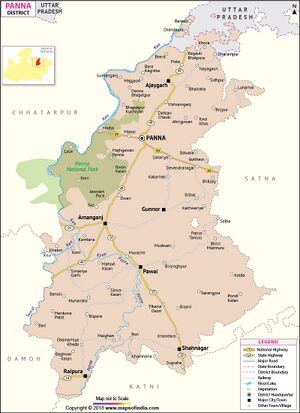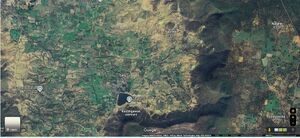Ganj Panna
| Author: Laxman Burdak IFS (R) |


Ganj (गंज) is a village in Gunnor tahsil in Panna district of Madhya Pradesh. It is the find spot of Ganj Stone Inscriptions of Vyaghradeva.[1]
Variants of name
Location
Ganj is a Village in Gunour Tehsil in Panna District of Madhya Pradesh State, India. It belongs to Sagar Division . It is located 45 KM towards South from District head quarters Panna. 15 KM from Gunour. 386 KM from State capital Bhopal. Ganj Pin code is 488333 and postal head office is Devendra Nagar. Bamurha ( 1 KM ) , Patna ( 2 KM ) , Bhulgawan ( 3 KM ) , Bhatiya ( 3 KM ) , Chhaparwara ( 4 KM ) are the nearby Villages to Ganj. Ganj is surrounded by Nagod Tehsil towards North , Pawai Tehsil towards west , Unchahara Tehsil towards East , Panna Tehsil towards North.[2]
Jat Gotras Namesake
- Ganj (Jat clan) → Ganj (गंज). Ganj (गंज) is a village in Gunnor tahsil in Panna district of Madhya Pradesh. It is the find spot of Ganj Stone Inscriptions of Vyaghradeva.[3]
History
Ganj Stone Inscriptions of Vyaghradeva
This inscription was discovered by Air. R. D. Banerji in 1919. It was edited for the first time with a facsimile and a translation by Dr. V. S. Sukthankar in the Epigraphia Indica, Vol. XVII, pp. 12 ff. It is edited here from the same facsimile.
The inscription is engraved on a detached slab of stone which Mr. Banerji found lying at the bottom of a donga, adjoining a hill called Maluha-tongi (मलुहा टोंगी) near Ganj in the former Ajayagadh state, now included in Madhya Pradesh. Close by is a ruined stone structure, probably a dam to hold the waters of the stream passing along the donga. The findspot of the present inscription is not far removed from the ruined city of Kuthara where the Nachne-ki-talai inscriptions were discovered.1
The present inscription is much better preserved than the preceding two records of the same king. The writing covers a space 2' 1" by 1'. As in the Nachne-ki-talai inscriptions, there is in the centre of the first line the figure of a wheel. The characters are of the box-headed variety of the southern alphabets, resembling closely those of the preceding two records. As observed by Sukthankar, they are unequal in size and uncouth in appearance. The language is Sanskrit and the whole record is in prose. The orthography shows the same peculiarities as in the two preceding inscriptions.
The inscription is of Vyaghradeva, who meditated on the feet of Vakataka Maharaja Prithivishena. He was evidently a feudatory of the latter. The object of the inscription is to record that Vyaghradeva did something, perhaps a dam to stem the waters of a stream for the religious merit of his parents. As shown before, this Vyaghra was probably identical withe the homonymous prince of the Uchchakalpa dynasty who flourished in circa 470-90 A.C.2 His suzerain was therefore probably the Vakataka king Prithivishena II.

Vyaghradeva who meditates on the feet of the illustrious Prithivishena (II), the Maharaja of the Vakataka, has made (this) for the religious merit of his mother and father.
1 Ep. Ind., Vol. XVII, p. 12.
2 Sukthankar referred the record to the seventh century Ac
3 From the facsimile facing page 12 in Ep. Ind., Vol. XVII
4 The superscript i is not clear.
5 Read कृतवानिति .
Wiki Editor Notes:
- Ganj (Jat clan) → Ganj (गंज). Ganj (गंज) is a village in Gunnor tahsil in Panna district of Madhya Pradesh. It is the find spot of Ganj Stone Inscriptions of Vyaghradeva.[4]
- Vaghere (वघेरे) (Jat clan) → Vyaghradeva (व्याघ्रादेव), mentioned in Nachane-Ki-Talai Stone Inscriptions of Vyaghradeva[5] and Ganj Stone Inscriptions of Vyaghradeva[6], was a vassal of Vakataka King Prithivishena II.
Notable persons
External links
See also
References
- ↑ Corpus Inscriptionum Indicarum Vol.5 (Inscriptions of The Vakatakas), Edited by Vasudev Vishnu Mirashi, 1963, Archaeological Survey of India, p.92
- ↑ http://www.onefivenine.com/india/villages/Panna/Gunour/Ganj
- ↑ Corpus Inscriptionum Indicarum Vol.5 (Inscriptions of The Vakatakas), Edited by Vasudev Vishnu Mirashi, 1963, Archaeological Survey of India, p.92
- ↑ Corpus Inscriptionum Indicarum Vol.5 (Inscriptions of The Vakatakas), Edited by Vasudev Vishnu Mirashi, 1963, Archaeological Survey of India, p.92
- ↑ Corpus Inscriptionum Indicarum Vol.5 (Inscriptions of The Vakatakas), Edited by Vasudev Vishnu Mirashi, 1963, Archaeological Survey of India, p.89-91
- ↑ Corpus Inscriptionum Indicarum Vol.5 (Inscriptions of The Vakatakas), Edited by Vasudev Vishnu Mirashi, 1963, Archaeological Survey of India, p.92

